
This parent guide supports parents in helping their child at home with the 8th grade Science content.
- Subject:
- Science
- Material Type:
- Reference Material
- Vocabulary
- Author:
- Kelly Rawlston
- Letoria Lewis
- Date Added:
- 10/11/2022

This parent guide supports parents in helping their child at home with the 8th grade Science content.

This resource accompanies our Rethink 8th Grade Science course. It includes ideas for use, ways to support exceptional children, ways to extend learning, digital resources and tools, tips for supporting English Language Learners and students with visual and hearing impairments. There are also ideas for offline learning.
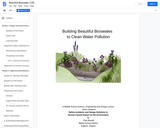
In this 1-2 week engineering design lesson, students will design and build water filters out of natural materials to simulate a filter system (bioswales) that cleans storm-water runoff before it soaks into the ground or enters a city’s storm-drain system. Their ultimate goal is to determine the combination and sequence of materials that best clean polluted water. Using materials easily found in pet stores and garden centers, students use the scientific method, students design to test and retest their designs and record, display and analyze their results.
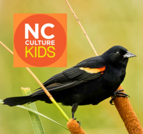
In this short video, join Emily and Emma from the Prairie Ridge Ecostation in Raleigh to take a look at some birds and learn about how we can observe all kinds of wildlife in our everyday lives.
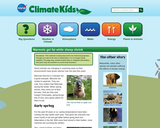
The effects of climate change on marmots in Colorado and sheep in Scotland are presented and compared. The Climate Kids website is a NASA education resource featuring articles, videos, images and games focused on the science of climate change.
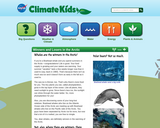
Arctic warming produces biological winners (whales) and losers (polar bears). This article explains why they are impacted differently and includes supplemental images. This lesson is part of the Climate Kids website, a NASA education resource featuring articles, videos, images and games focused on the science of climate change.
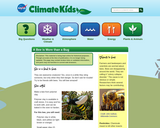
In addition to instructions for making a model bee out of polymer clay, this site also contains related information about bees: a fact list, factors that threaten them, suggestions on how to help them, a waggle dance diagram and video, and even bee metaphors used in our language. The Climate Kids website is a NASA education resource featuring articles, videos, images and games focused on the science of climate change.
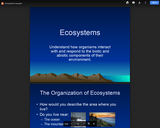
This is a Google slideshow that contains all of the information for the 8th grade Ecosystems unit.

The North Carolina Museum of Natural Science created this resource as part of an online workshop series, but you are welcome to use or modify it for your classroom. It includes a video and written directions for creating nature journals and tips for incorporating them into your classroom. For information on taking any the Nature Neighborhood online workshops for CEUs or EE credit, visit: https://naturalsciences.org/learn/educators/online-workshops.

This lesson will incorporate how organisms affected at one trophic level in an ecosystem can change the entire structure of the ecosystem. The students will gain an understanding that human impact through deforestation, climate change and even restoration effort can alter an ecosystem's flow of energy through a food web which can have a chain effect spreading through the entire food web. The affect could cause an entire ecosystem to collapse especially if the original organism affected is a keystone species or an umbrella species. Students will learn that the extinction of the polar bears will cause devastation on the Arctic ecosystem that may cause the extinction of world biome.This lesson was developed by Elizabeth Bartlett as part of their completion of the North Carolina Global Educator Digital Badge program. This lesson plan has been vetted at the local and state level for standards alignment, Global Education focus, and content accuracy.

Students will be working in a group of four. Students will be given a situation that has occurred within their given world ecosystem. The situation could be a disease that has infected a certain species of animal, resulting in eradication. What happens to your food web and how might this situation be avoided in the future? Students will then create a three-minute video newscast using moviemaker or screencast in order to communicate what has happened to their ecosystem and how scientists are working to make certain that this does not occur in the future. Students can use their notes or internet search to investigate the situation that is occurring within their world ecosystem.This lesson was developed by Elizabeth Bartlett as part of their completion of the North Carolina Global Educator Digital Badge program. This lesson plan has been vetted at the local and state level for standards alignment, Global Education focus, and content accuracy.

Students will investigate an ecosystem of their choice and then create a food web poster with at least 30 organisms. The students will have different sections that will include food web, food chain, energy pyramid, invasive species, and symbiosis, climate and population factors within an ecosystem. This is the summative lesson of the unit. This will allow the student to apply all the information that has been learned throughout the unit. The students will demonstrate through analyzes how an ecosystem is an interconnected ever changing system that incorporates many factors that affect organisms living in the ecosystem.This lesson was developed by Elizabeth Bartlett as part of their completion of the North Carolina Global Educator Digital Badge program. This lesson plan has been vetted at the local and state level for standards alignment, Global Education focus, and content accuracy.

Students will investigate an invasive species. Two students in the class will be investigating the same invasive species. Once they have investigated on their own, the two will then collaborate to create a visual presentation using technology, such as PowerPoint, Google Slides, or Prezi, to present to the class. This lesson will inform students about the destructive nature of species being transferred from one ecosystem to another ecosystem. The lesson will introduce students to invasive species throughout the world and how they affect ecosystems. During the lesson students will be able to determine different methods of transport for invasive species such as the ones that can hitch rides to those that have been purposely introduced by humans.This lesson was developed by Elizabeth Bartlett as part of their completion of the North Carolina Global Educator Digital Badge program. This lesson plan has been vetted at the local and state level for standards alignment, Global Education focus, and content accuracy.

Lesson one allows students to explore the interconnection between organisms and the environments they make their homes. They will begin with investigating how food webs, food chains and energy pyramids are different and similar throughout the world. By analyzing food webs, food chains, and energy pyramids, the students will be able to discover how different organisms in different ecosystems throughout the world utilize each other for their own survival. This lesson specifically addresses the need for students to understand how organisms within an ecosystem interact with each other. It will include the interaction of producers, consumers, and decomposers as energy flows through the ecosystem.This lesson was developed by Elizabeth Bartlett as part of their completion of the North Carolina Global Educator Digital Badge program. This lesson plan has been vetted at the local and state level for standards alignment, Global Education focus, and content accuracy.

The students will collaborate in groups of four to determine who will investigate each limiting factor that affects an ecosystem's population. The students will examine limiting factors of the world ecosystems and how organisms adapt to certain niches to survive. They will break apart and complete the investigation independently. After they have completed their investigation, the students will return to their groups and collaborate on the creation of a poster for all four population factors. The students will complete a gallery walk, thus communicating ideas on how each group can improve their population factors.This lesson was developed by Elizabeth Bartlett as part of their completion of the North Carolina Global Educator Digital Badge program. This lesson plan has been vetted at the local and state level for standards alignment, Global Education focus, and content accuracy.

The Ecology Student Edition book is one of ten volumes making up the Human Biology curriculum, an interdisciplinary and inquiry-based approach to the study of life science.
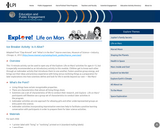
This is a set of two improv-style activites that encourage participants to participate in learning about living and nonliving things. Learners will get to know each other through an icebreaker activity and state their ideas and previous experience with living versus nonliving things. This will help prepare them to explore how scientists define and look for life in worlds beyond our own. It also includes specific tips for effectively engaging girls in STEM. This is the icebreaker activity in Explore: Life on Mars? that was developed specifically for use in libraries.

This unit investigates the delicate balance of an ecosystem through the disruptive effects of an invasive species. Students look at various case studies of different invasives, most of which affect ecosystems in Michigan. The great Lakes provide a backdrop for an exploration of food webs, predator-prey interactions, and trophic levels through the lens of the changes caused by the introduction of an invasive species.
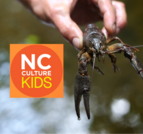
In this short video, students join Emily and Dr. Bronwyn Williams from the North Carolina Museum of Natural Sciences as they head to three different North Carolina locations to explore the world of crayfish!
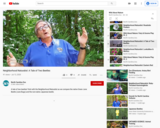
A tale of two beetles! Visit with the Neighborhood Naturalist as we compare the native Green June Beetle (June Bugs) and the non-native Japanese beetle.